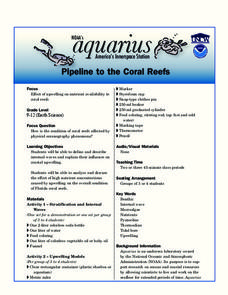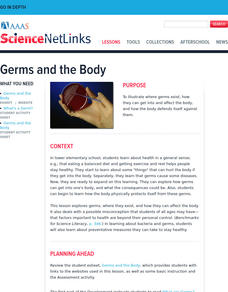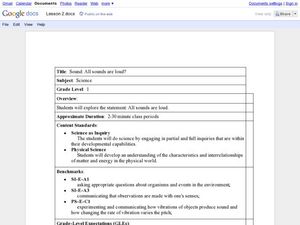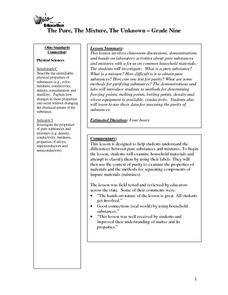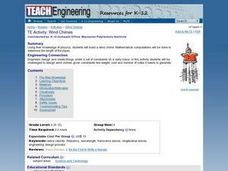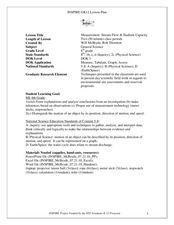Polar Trec
Polar Detectives: Using Ice Core Data to Decode Past Climate Mysteries
How does examining an ice core tell us about weather? Learners set up and explore fake ice cores made of sugar, salt, and ash to represent historical snowfall and volcanic eruptions. From their setups, scholars determine what caused the...
Curated OER
Weather Instruments
Third graders practice making predictions about weather from conditions they observe on weather instruments and weather reports. Learners are introduced to the most basic weather reporting instruments: the thermometer, the wind vane, the...
Florida International University
Pipeline to the Coral Reefs
Discover firsthand the effects of internal waves on coral reefs. Through a series of experiments, learners simulate internal waves and upwelling events as they make observations on the movement of water and other debris. They then...
Curated OER
Levers and Wedges in the Human Body
Learners identify the various parts of the body that serve as wedges and levers, identifying the fulcrum for each body lever. They bite into carrots and apples to analyze how their jaws and teeth work, then complete three worksheets that...
Space Race
Sensory Detectives
Test your learners' sensory awareness with three hands-on activities that ask pupils to use their other senses to identify and describe everyday objects hidden from sight.
Curated OER
A Sense of West Virginia
Students consider their perceptions of the world through their 5 senses while visiting the West Virginia State Museum. In this West Virginia history lesson, students discover how knowing about the past helps with their understanding of...
Curated OER
Puberty
Eighth graders describe the changes their body undergoes during puberty. In this health science lesson plan, 8th graders explain how the hypothalamus and pituitary gland play a major role in the process. They identify the different parts...
Curated OER
Microscopes and Crystals
Students observe crystals under the microscope. In this science lesson, students compare how the crystal look like using their eyes, hand lens and microscope. They identify the type of crystal based on the amount of light they allow to...
Curated OER
Mineral Lab
Eighth graders examine the physical properties of different minerals. In this earth science lesson, 8th graders explain the uses of minerals in their daily lives. They complete the mineral identification table during the lesson.
Curated OER
Environmentalism: Then and Now
Tenth graders examine the history of the conservation movement and how it relates to contemporary issues. In this Environmental Science activity, 10th graders research the roots of the environmental and conservation movement and...
Curated OER
Critter Characteristics
Students explore the adaptations of deep sea life forms. In this science lesson, students watch a video to observe characteristics which allow for the sea creature to thrive in it's environment. Students determine the physical,...
Curated OER
Cool Liquids
Chemistry neophytes use a temperature probe to assess the change as five different liquids evaporate. The implantation section suggests that they take readings every five seconds for a total of four minutes. They graph the data, look up...
Curated OER
Science: Wind Power
Students build models of wind turbines and experiment with different designs that will improve efficiency. Students will understand the use of wind power as a renewable resource.
Curated OER
What Can I Do?
Students explore ways to handle conflict. In this mental health activity, students investigate ways to tell others how they feel and discover that identifying their emotions can help them resolve conflict.
Curated OER
Flying Too Close to the Sun
High schoolers research the myth of Icarus and his father and discuss the associated metaphor. They view the work of a number of artists and create a painting depicting the myth.
Curated OER
Sound: Are All Sounds Loud?
First graders explore physics by utilizing education software. In this sound properties lesson, 1st graders discuss the different sounds associated with different materials and perform an object dropping experiment in class. Students...
Curated OER
Solids, Liquids, and Gases
Students explore the three main forms of matter: solid, liquid, and gas. They examine concrete examples of each, using their five senses and "experimenting" to find differences in them. They find pictures of each, cut them out and past...
Curated OER
What is electrical energy?
Students distinguish between items with and without energy. In this energy lesson, students understand that natural resources power electrical apparatus and that energy needs to be saved.
Curated OER
Dive In
Students study how buoyancy, pressure, and light can effect the work of underwater scientists. In this marine science lesson students complete a lab that allows them to better understand how pressure varies with altitude and depth.
Curated OER
The Pure, The Mixture, The Unknown
Ninth graders participate in classroom discussions, demonstrations and hands-on laboratory activities about pure substances and mixtures with a focus on common household materials. They investigate: What is a pure substance? What is a...
Curated OER
Wind Chimes
Students construct wind chimes using physics. In small groups they design and create wind chimes using a specific weights, number of notes, and keeping the cost under ten dollars.
Curated OER
Modeling the Process of Mining Silicon Through a Single Displacement/Redox Reaction
Students study silicon and where it comes from. In this solar mining lesson plan students complete an Internet search of mining and a lab activity.
Curated OER
Measurement: Stream Flow & Stadium Capacity
Eighth graders study the scientific fields and how information can be monitored and recorded. For this scientific inquiry lesson students view a PowerPoint presentation and complete a hands on activity.
Curated OER
A Pre-Treatment Model for Ethanol Production Using a Colorimetric Analysis of Starch Solutions
Students recognize the benefits of ethanol and study photosynthesis. In this ethanol instructional activity students complete an experiment that shows the procedure that starch can be hydrolyzed by salivary amylase.




